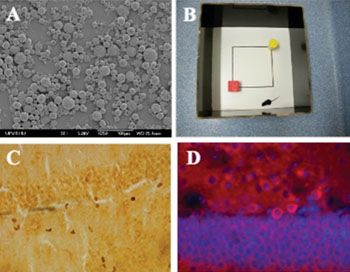Micro-, Nano-particles Designed to Enhance Treatments for Alzheimer’s and Parkinson’s
By LabMedica International staff writers
Posted on 30 Oct 2014
Techniques are being developed to effectively deliver specific drugs to treat Alzheimer’s and Parkinson’s disease. Posted on 30 Oct 2014
Both of these disorders affect the neurons: their structure and function is lost, and this in turn leads to the deterioration in the patient’s motor, cognitive, sensory, and emotional functions. Dr. Enara Herran, a researcher at the University of the Basque Country’s (UPV/EHU; Bilbao, Spain) department of pharmacy and pharmaceutical technology, is trying to improve the way Alzheimer’s and Parkinson’s treatments are administered.

Image: (A) Biodegradable polymeric nanoparticles. (B) Test to analyze short-term memory in transgenic mice with Alzheimer. (C and D) Markers to analyze neurogenesis (Photo courtesy of the University of the Basque Country).
Both disorders affect the neurons: their structure and function is lost, and this then leads to the deterioration in the patient’s sensory, motor, cognitive, and emotional functions. As Dr. Herran emphasized, in many instances the agents used to treat both Alzheimer’s and Parkinson’s only alleviate the symptoms; they do not act on the origin of the disease. “The treatment is usually on the basis of tablets taken by mouth.”
However, drugs of this sort are not the only ones used to tackle both Alzheimer’s and Parkinson’s disease. Some drugs prevent neuron loss and help new ones to form, growth factors, for example. “In any case, they are not used so much because there is no effective, safe way of delivering them,” said Dr. Herran. As the researcher further clarified, the drugs have to pass through the blood-brain barrier (BBB) to reach the neurons, and that is no easy task. This is in fact the drawback Dr. Herran is seeking to overcome with her research.
“Growth factors are encapsulated so that they can be administered more effectively and more safely. In other words, they are inserted into micro- and nano-capsules and implanted in the brain by means of craniotomy. That way, the drugs would be released right where they have to act, and what is more, in an ongoing way and in the correct dose,” explained Dr. Herran.
The micro- and nano-particles release these growth factors within a time period ranging from two to three months and one year until the polymer has degraded. That way, the patient does not have to take the medication daily. In any case, this is not the only advantage. In a study perfromed on rats and mice the encapsulated drugs have been found to be much more effective than those taken orally. As Dr. Herran noted, “these two diseases are already a problem for public health, and the scientific community is making a great effort in the quest for and in advances in new treatments.”
Dr. Herran explained, in experiments conducted on animals they have evaluated two factors—the vascular endothelial growth factor (VEGF) and the glial cell-line derived neurotrophic factor (GDNF)—encapsulated in a biocompatible, biodegradable polymer-poly (lactic co-glycolic acid) (PLGA). “We obtained micro- and nano-particles using various encapsulation techniques. Initially, we did the tests for Parkinson’s; first in cell cultures and then on mice. We got good results in both trials.” Dr. Herran stressed that the mice treated with particles improved sustainably. “A great improvement was noted in comparison with the control group in terms of behavior as well as the healing of the damaged zones.”
After that, they performed the test for AD in lab mice. Dr. Herran reported that in this instance they also achieved good results, “Three months after having carried out the procedure, the mice treated had good memories; similar to those of healthy mice. Through a histological analysis we found that the beta-amyloid plaques that develop in Alzheimer’s had diminished considerably and so had the inflammation, and that angiogenesis had intensified.”
The study’s findings have been publicized in specialized publications including October 12, 2014, in the Journal of Controlled Release. Moreover, this is in fact the subject of Dr. Herran’s PhD thesis. Although the research has not been completed, Dr. Herran noted that she is now doing research to obtain “better formulations,” so as not to have to implant the micro- and nano-particles in the brain. The final objective is clear: to develop the most effective, safest, and most effective way of treating Parkinson’s and Alzheimer’s.
Related Links:
University of the Basque Country








 (3) (1).png)




